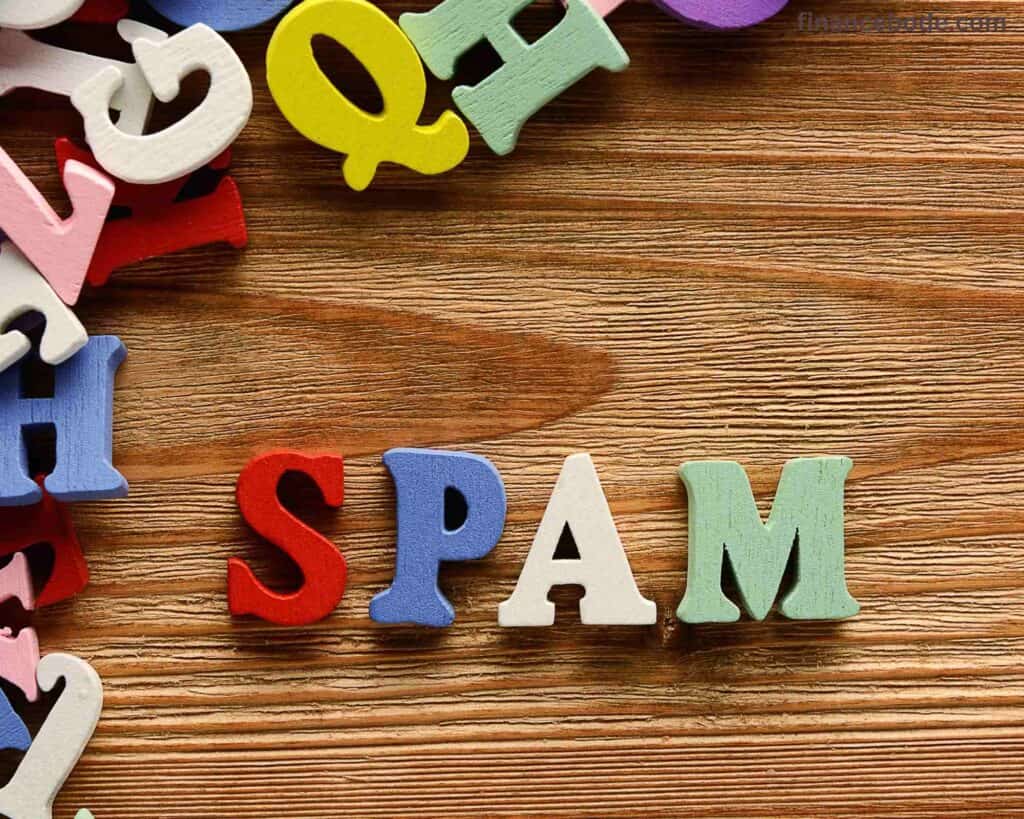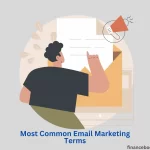What is a spam filter on email? These are software or program designed to detect and block unsolicited and unwanted emails, commonly known as spam.
FinanceBode revealed that marketers that routinely operate email marketing campaigns might confront challenges linked to spam filtering.
According to studies, roughly 46% of emails, even with the recipient’s consent, are deemed to be in the spam folder.
Spam filters and Internet service providers (ISPs) are working harder than ever to defend consumers’ rights from being disturbed by spam emails.
Therefore, it’s time to discover what a spam filter is. How spam filtering and firewalls operate, and how to avoid spam filters. With these notions in mind, you will uncover strategies to increase your email deliverability.
What Is A Spam Filter?
Spam/Spam emails are emails not intended by receivers, tainted with viruses or include spam components.
They will be stopped by spam filters and not forwarded to the Inbox.
The spam filter is applied to incoming emails (emails entering the network) and outgoing emails (emails leaving the web).
ISPs utilize both strategies to safeguard subscribers. For example, Gmail, Microsoft Outlook, etc. Many small and medium enterprises generally rely primarily on incoming spam filtering systems.
Why Do Mailbox Providers Build Spam Filtering Systems?
The spam issue is only bothersome for the receiver. So why do mailbox providers construct spam filtering systems? Gmail is free to use. Why did they devote millions of dollars to build these complicated filters?
Mailbox providers build spam filtering systems majorly because they want people to utilize their products. The more users the unit has, the more money may be generated.
If consumers enjoy the finest, spam-free experience using Gmail, they will utilize Gmail as their main Inbox.
Also, a key reason spam email is screened is crucial because it might include hazardous information that spreads viruses and cyber assaults. One email may take down a major corporation.
Consequently, corporations seek the greatest protection for their personnel and networks. A very safe and secure mailbox service would be the obvious option.
What Can Spam Detect?
Spam filters identify unsolicited, unwanted, and virus-infested emails (called spam) and prevent them from entering email inboxes. Internet Service Providers (ISPs) utilize spam filters to make sure they aren’t transmitting spam. Small- to medium-sized enterprises (SMBs) also use spam filters to safeguard their workers and networks.
Spam filters are applied to both incoming emails (emails entering the network) and outgoing emails (emails leaving the network). ISPs utilize both strategies to safeguard their clients. SMBs often concentrate on incoming filtering.
There are various spam filtering methods available. They may be hosted in the “cloud,” on computer servers, or in email applications like Microsoft Outlook.
How Does Spam Filters Work?
How does Gmail’s spam filter work?
2 billion individuals use Gmail every month, and more than 5 million companies pay Google to use their own domain names.
Gmail Inbox
Gmail separates Inbox into 3 sections:
- Primary: Emails from individuals you know (and messages that don’t display on other tabs)
- Social networks: Messages from social networks and media-sharing sites
- Promotions: Deals, offers, newsletters and other “call-to-action” emails
If your email is sent to one of these 3 things, feel easy since this is regarded as the primary Inbox of Gmail. It will not harm your domain name and IP address reputation.
In addition to 3 things in the Inbox: main, social and advertising. Gmail separates other emails into
- Updates: Notifications, confirmations, receipts, bills and statements
- Forums: Messages from online groups, discussion boards, and mailing lists
- Spam: Suspected mail having improper material for the receiver
Gmail utilizes a combination of rule-based and machine learning filters, most recently adding TensorFlow-based AI into their spam filter.
What makes your email send to spam in Gmail?
Let’s take a look at some of the criteria that affect if your marketing emails convert to spam.
IP and domain name reputation
Gmail analyzes both the sender’s domain name and IP address when selecting where to put an email.
Gmail suggests setting up adequate authentication for your outgoing email to guarantee that your communications are not banned or censored.
User Commitment
Gmail’s algorithms appear to take each user’s inbox activities extremely seriously when choosing which emails to send as spam. What could be spam for you is marketing for me and Inbox for others.
Examples of user behaviours that negatively influence deliverability:
- Messages were removed without being read
- Messages designated as spam
- Report or complaint spam
- The message has been sent to the promotion
Examples of user behaviors that positively improve deliverability:
- Email is voted as non-spam
- Messages with an asterisk
- Messages forwarded
- Messages read
- Message responded
To avoid your email from turning into spam in Gmail, you need to make sure that you frequently delete your never-participating list of subscribers.
You also need to adopt a different email marketing approach for passive subscribers or those with reduced interaction.
Content
Your email’s title, text, picture, and link are all essential criteria in assessing whether an email is spam, promotional, social, or inbox-worthy.
The material is still part of the email filtering algorithm. However, the sender’s reputation appears to be overstated.
Avoiding the phrase “spam” doesn’t appear to be as critical as keeping a high degree of subscriber interaction.
See also: Spam words to avoid in an email.
Sending History
Gmail’s default action on new IP addresses is to temporarily ban them for the first 2-24 hours.
Then a tiny number of emails are sent to the Inbox. Another small group is sent to spam to check the recipient’s reaction.
If this first test results in a high complaint rate, most subsequent emails will end up in spam.
On the other hand, if the receiver diverts the message from spam by choosing “This is not spam,” Gmail will consider it a safe address to send the message to.
How to prevent email from turning into spam in Gmail
The best strategy to stop emails from going to spam in Gmail is as follows:
- Follow the set of “CAN-SPAM Principles.”
- Arrange the shipping schedule equally, not too much
- Content does not include spam terms in email marketing
- Always review the list before submitting
See also: Email marketing laws you should know.
How does Outlook identify spam?
Microsoft pays attention to engagement, complaints, spam traps, and other characteristics comparable to Gmail.
However, Outlook also employs a “Sender Reputation Data network” (SRD) to filter spam. Microsoft employs a set of random votes from active Outlook users to create the filter.
Sent emails will be accompanied by a notice requesting to vote on whether the original email was “Junk” or “Not Junk”.
A high “Junk” vote might lead to your future emails being more likely to wind up in the spam box.
However, for this approach, the sender may simply manipulate the complaint rate by sending a bigger volume of emails to minimize the number of complaints.
How to prevent email from going to spam in Outlook
As with other providers, following best practices is to constantly review your list of interrupted contacts, authenticate emails, and deliver quality material.
High quality and relevance will lower your email’s chances of getting spam in Outlook.
How does Yahoo filter spam?
Yahoo’s spam filter contains the following elements:
- Reputable IP address
- Reputation URL
- Reputable domain name
- Reputation of the sender
- Autonomous System Digital Reputation (ASN)
- DomainKeys Identity Message Signature (DKIM)
How to stop email being forwarded to spam in Yahoo
According to information from Yahoo: “If you send email at a certain rate and suddenly there is a spike in activity, you may be flagged as a compromised sender and marked as spam.
Instead, design your campaign and stretch it out over a predetermined length of time.”
You may subscribe to Yahoo’s “Complaint Feedback Loop” to receive alerts when people designate your email as spam or complain.
If you continue to suffer deliverability difficulties with Yahoo Mail, you may submit your sending IP address directly to Yahoo for assessment.
Types Of Spam Filters
There are three kinds of spam detection systems your email will likely face. The categorization is based on where they occur during email delivery.
1 – Spam filter at the entry (Gateway)
Gateway spam filtering system – Incoming port filtering – as the name implies, is generally positioned behind the network’s firewall. It monitors for any dangers to the network.
Typically, port filters are entirely physical hardware. They are co-located with the servers instead. Incoming emails from outside will have to pass through a “security gate” before accessing the business network.
2 – Cloud-hosted spam filtering system
Unlike Gateway Filtering, hosted spam filters are often cloud-based. But the way it works is identical to the gateway spam filter.
It identifies any possible spam or harmful emails. For example, Gmail, Microsoft Outlook, etc.
One advantage of cloud-hosted spam filters is that they are promptly updated with the newest software. This enables consumers to always have the most up-to-date items.
Hosted spam filters are generally maintained by third parties and provide subscription services.
3 – Desktop spam filter
Filters on the Desktop are configured by the user. They are normally downloaded locally to the computer.
The benefit of desktop spam filters is that they may be custom adjusted. This allows the relevant filtering mechanisms to be enabled according to user demands. For example, Avast software.
The categories above are only a few of the many types of spam email filters that still exist. Spam filters come in different forms and sizes and are typically used in conjunction to increase security.
Next, we will find out what criteria spam detection systems judge spam based on.
What Are The Factors That Determine If Your Emails Go To Spam Or Inbox
To understand how spam filters function, we first need to understand the variables they employ to recognize spam.
Let’s have a look at the variables by which the 3 main email service providers (ESPs) detect spam.
Source IP
IP is your unique identification online. One of the first elements email service providers looks at when deciding if an email is spam is the sender’s IP address.
If a given IP address has received numerous complaints in the past, email from that address is more likely to be classified as spam.
Sometimes emails from an IP with a very bad reputation may not be accepted by the server.
Domain Name Reputation
Email service providers evaluate not just the sender’s initial IP address but also the sender’s domain name and even the sender’s personal alias.
Assume emails from @yourcompany.com are generally trashed, not opened. Service providers will believe that your email is not a high priority for most individuals, resulting in spam.
On the other side, if an email from your organization is clicked, opened, whitelisted, forwarded, responded to, etc., your domain reputation will be much appreciated.
Spam Trap
If a person quits using an email account, email providers might cancel the account. After an email account is locked, ESP may occasionally recycle the email address and convert it into a “spam trap”.
Submissions to spam traps will not produce interactions. But your IP reputation and the domain name will suffer.
Email service providers occasionally place bogus email addresses on the web, forums, etc., to mislead bulk email scanning programs.
These addresses may be on email lists for sale online. Sending an email to one of these “spam traps” may get the sender harshly fined and potentially ban you.
See more about Email spam traps and how to avoid them.
Blacklist
A blacklist is a list of spammers’ IP addresses. The spammers are individuals who have switched off the spam filter, enabling all emails to get to the main Inbox.
If you send an email to one of these lists, the email service provider (ESP) will most likely recognize your email as spam.
Read more about the email blacklist HERE.
Send rate
Sometimes the email may not reach the Inbox solely because too many messages are sent in at once.
If you send identical email content to too many recipients in a short period, your email may also wind up in the spam box.
So altering or spreading your email distribution across time might boost the chance of your messages reaching your main Inbox.
Content
Using “spam” words can lead to detecting emails as spam; thus, when preparing emails, it is crucial to avoid spam phrases in email marketing.
Today’s spam filters are more complex, and most algorithms seek patterns in text rather than particular words or phrases.
So it’s apparent that content plays a role in screening out spam emails. If you send low-quality material, your readers are less likely to interact and may even designate your email as spam.
Spam Email Filtering Method
What do filtering systems check for in emails to determine whether to ban or discard them?
Content Filtering
The topic and text of the email is always the major component in the initial examination. Why?
- The title will give a lot of valuable information. Like the sender address, the response receiving address, the server is delivering the email to…etc. Consider this criterion to make sure the sender is not on any Blacklist. Or does not include any suspicious stops delivered to the addressee.
- Besides the header, the content filter examines suspicious components in the body of the email, such as spam-related trigger phrases or pictures.
There is a narrow line between good and poor content in the eyes of the content filter. I think this is the main error that reputable marketers commonly commit.
Three crucial things to consider while producing email content to prevent spam reviews
1. Content may not be contained wholly inside an image; There should be a balanced picture-to-text ratio. Example: 20 pictures – 80 text.
2. Avoid terms that activate the spam filter. Like “free”, “free”, “special offer”; ALL CAPTCHAs;…vv
3. If you create mass promotional emails, they must contain a legitimate physical company address. Comes with a straightforward unsubscribe mechanism.
Rule-based filtering
Rule-based filters enable specific emails to be filtered based on established criteria.
For example, it is feasible that people will restrict material from a given sender. Or the email has particular terms in the subject line or subject line.
Bayesian filter – Filter by behavior
The Bayesian filter is a filter that learns the recipient’s spam rating preferences.
When you flag an email as spam, the system will record the characteristics of this email. Then seek similar features in additional incoming emails.
It will filter everything that fits the content and then transfer it to the spam box.
The Bayesian filter is one of the most sophisticated forms of spam detection systems since it can learn and adapt on its own.
Conclusion
Anti-spam filters are all configured with tight email verification criteria. Every time someone hits the “Report Spam” button, the filter will instantly receive and share the information for other filters.
There is no method for email to get through without any screening mechanism. But there are various techniques to prevent your emails from getting to recipients’ spam mailboxes.
- Do not email yourself.
- The email contains just one photo.
- The email topic and body do not match.
- The URL address included in the email body must be trustworthy.
- Check email exists before sending.
- Be careful to use standard HTML.
- Do not copy email text from Word, from the web…etc
Good luck!
FAQs about Spam Filters
How do spam filters decide whether an email is spam?
Spam filters utilize a mix of methods such as content filtering, blacklisting, whitelisting, and statistical analysis to decide whether an email is spam.
They assess many elements, including the email’s content, sender reputation, and trends associated with spamming, to provide a spam likelihood score.
Can spam filters block legitimate emails?
Yes, Although spam filters aim to filter out just spam communications, false positives might occur. Legitimate emails may occasionally be wrongly labeled as spam and wind up in the spam folder.
Whitelisting key senders or periodically monitoring the spam folder might help alleviate this problem.
Are spam filters effective in stopping all types of spam?
While spam filters are very effective in filtering a major part of spam, they may not capture all varieties.
Spammers continuously adapt their strategies to avoid filters, and some sophisticated spam may still find its way through.
Regular changes to spam filters and user attention are important to resist new spamming strategies.





